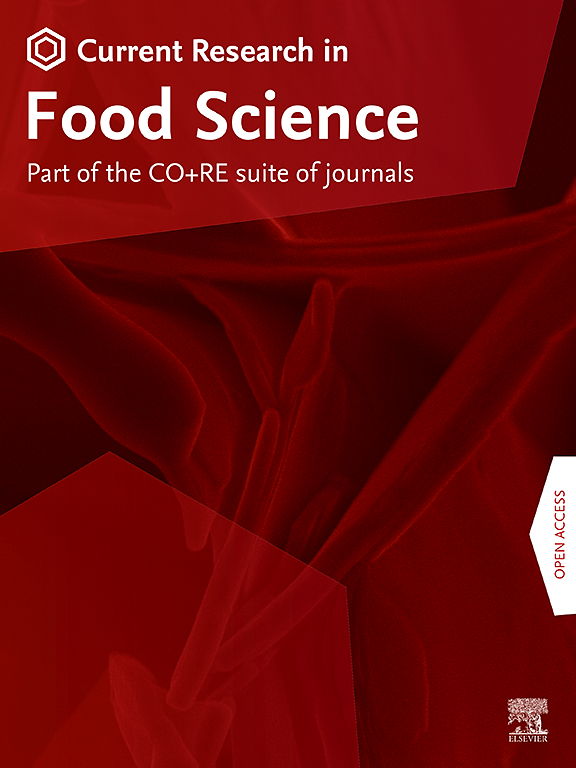Patterns of sensory and hedonic responses for salty and umami tastes and their impact on food familiarity, consumption, and nutritional status: A gender-based analysis from a large population sample
IF 6.2
2区 农林科学
Q1 FOOD SCIENCE & TECHNOLOGY
引用次数: 0
Abstract
In recent years, research on taste perception has increasingly focused on its influence on food consumption, preferences, and long-term health. While bitter and sweet tastes have been well-studied, less is known about salty and umami tastes and their effects on dietary habits. This study aimed to address this gap by exploring sensory-hedonic patterns for ‘savory’ stimuli, encompassing both umami and salty tastes, in a representative sample of Italian adults, with a focus on gender-specific differences. Associations among sensory-hedonic patterns, nutritional status, personality, and psycho-attitudinal traits, as well as food habits, were considered.
Participants (n = 2878) rated their liking and intensity of salty, umami, and overall flavor sensations for bean purée with varying salt levels and provided anthropometric and food consumption data. K-means clustering identified specific sensory-hedonic patterns: ‘Dislikers’ and ‘Moderate Likers’ in women, and ‘Dislikers’ and ‘Likers’ in men. In both genders, the increased concentration of NaCl in the model food translated in opposite hedonic reactions, which was less evident in men with ‘Likers’ showing a higher preference for the saltiest sample. An overweight condition also characterized this latter group. Both 'Likers' clusters (regardless of gender) showed higher familiarity/consumption of less healthy foods, including high-calorie items, junk foods, meat, and fats (all p < 0.05). Gender-related differences were observed, with women preferring seafood and desserts, while men savory snacks and soft drinks. These results underscore taste's influence on dietary habits and the need to account for gender differences in personalized dietary interventions.

咸味和鲜味的感官和享乐反应模式及其对食物熟悉度、消费和营养状况的影响:一项基于性别的大型人口样本分析。
近年来,味觉感知对食物消费、偏好和长期健康的影响越来越受到关注。虽然苦味和甜味已经得到了充分的研究,但咸味和鲜味以及它们对饮食习惯的影响却鲜为人知。这项研究旨在通过探索“美味”刺激的感官享乐模式来解决这一差距,包括鲜味和咸味,在意大利成年人的代表性样本中,重点关注性别差异。感官享乐模式、营养状况、人格和心理态度特征以及饮食习惯之间的联系也被考虑在内。参与者(n = 2878)评估了他们对不同盐含量的豆豆的咸度、鲜味和整体味道的喜爱程度和强度,并提供了人体测量和食物消耗数据。K-means聚类确定了特定的感官享乐模式:女性为“不喜欢者”和“中等喜欢者”,男性为“不喜欢者”和“喜欢者”。在两种性别中,模型食物中NaCl浓度的增加会导致相反的享乐反应,这在“喜欢者”对最咸的样品表现出更高偏好的男性中不太明显。超重也是后一组人的特征。两个“喜欢者”群体(不分性别)都对不健康的食品(包括高热量食品、垃圾食品、肉类和脂肪)表现出更高的熟悉度/消费量
本文章由计算机程序翻译,如有差异,请以英文原文为准。
求助全文
约1分钟内获得全文
求助全文
来源期刊

Current Research in Food Science
Agricultural and Biological Sciences-Food Science
CiteScore
7.40
自引率
3.20%
发文量
232
审稿时长
84 days
期刊介绍:
Current Research in Food Science is an international peer-reviewed journal dedicated to advancing the breadth of knowledge in the field of food science. It serves as a platform for publishing original research articles and short communications that encompass a wide array of topics, including food chemistry, physics, microbiology, nutrition, nutraceuticals, process and package engineering, materials science, food sustainability, and food security. By covering these diverse areas, the journal aims to provide a comprehensive source of the latest scientific findings and technological advancements that are shaping the future of the food industry. The journal's scope is designed to address the multidisciplinary nature of food science, reflecting its commitment to promoting innovation and ensuring the safety and quality of the food supply.
 求助内容:
求助内容: 应助结果提醒方式:
应助结果提醒方式:


